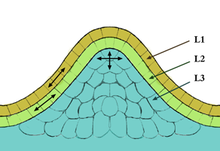**1. Meristem Types and Functions:**
– Primary Meristems:
– Apical meristems give rise to the primary plant body.
– Protoderm develops into the epidermis.
– Procambium develops into primary xylem and primary phloem.
– Ground meristem develops into the cortex and the pith.
– Cork cambium produces periderm, phellem, and phelloderm.
– Secondary Meristems:
– Lateral meristems develop as secondary plant growth.
– Vascular cambium produces secondary xylem and phloem.
– Cork cambium gives rise to periderm.
– Secondary growth adds to plant diameter.
– Arboraceous plants exhibit secondary growth.
**2. Apical Meristems and Their Functions:**
– Apical Meristems:
– Completely undifferentiated meristems in a plant.
– Differentiate into primary meristems.
– Produce secondary meristem types.
– SAM gives rise to leaves and flowers.
– RAM provides meristematic cells for future root growth.
– Shoot Apical Meristems:
– Source of above-ground organs like leaves and flowers.
– Site of most embryogenesis in flowering plants.
– Initiate primordia of various plant parts.
– Consists of stem cells and founder cells.
– Maintained by a complex signaling pathway.
**3. Meristem Characteristics and History:**
– Meristem History:
– Term first used in 1858 by Carl Wilhelm von Nägeli.
– Derived from Greek word meaning ‘to divide’.
– Three types of meristematic tissues: apical, intercalary, lateral.
– Central zone cells have stem cell function.
– Proliferation rates differ at meristem summit and periphery.
– Shoot Apical Meristem and Root Apical Meristem:
– Various characteristics and functions of root and shoot apical meristems.
**4. Meristem Growth and Regulation:**
– Apical Dominance:
– Dominant meristem inhibits growth of other meristems.
– Auxins play a key role in apical dominance mechanism.
– Removal of dominant meristem leads to branching and new growth.
– Strigolactones are involved in inhibiting branching in apical dominance.
– Recent studies show the role of strigolactones in branching control.
– Role of the KNOX-family Genes:
– KNOX genes maintain stem cells in an undifferentiated state.
– The KNOX family has diversified evolutionarily across plant species.
– Misexpression of KNOX genes can lead to unique morphological features.
– KNOX genes are involved in leaf shape evolution.
– KNOX gene action is conserved in vascular plants.
**5. Meristem Growth and Applications:**
– Cloning and Induced Meristems:
– Shoot meristems can develop into new plants under suitable conditions.
– Asexual reproduction through cloning is common in horticulture.
– Mericloning helps reduce viruses in parent plants.
– Propagation through cuttings initiates root or shoot production.
– Basal wounding of cuttings aids in root formation.
– Induced Meristems:
– Meristems can be induced in legume roots after infection with Rhizobia.
– Nod factor plays a critical role in inducing cell division.
– Regulation of nodule meristems involves autoregulation of nodulation.
– Specific receptor proteins are involved in nodule meristem regulation.
– AON process involves similar mechanisms seen in the CLV system.
The meristem is a type of tissue found in plants. It consists of undifferentiated cells (meristematic cells) capable of cell division. Cells in the meristem can develop into all the other tissues and organs that occur in plants. These cells continue to divide until they become differentiated and lose the ability to divide.

Differentiated plant cells generally cannot divide or produce cells of a different type. Meristematic cells are undifferentiated or incompletely differentiated. They are totipotent and capable of continued cell division. Division of meristematic cells provides new cells for expansion and differentiation of tissues and the initiation of new organs, providing the basic structure of the plant body. The cells are small, with small vacuoles or none, and protoplasm filling the cell completely. The plastids (chloroplasts or chromoplasts), are undifferentiated, but are present in rudimentary form (proplastids). Meristematic cells are packed closely together without intercellular spaces. The cell wall is a very thin primary cell wall.
The term meristem was first used in 1858 by Carl Wilhelm von Nägeli (1817–1891) in his book Beiträge zur Wissenschaftlichen Botanik ("Contributions to Scientific Botany"). It is derived from the Greek word merizein (μερίζειν), meaning to divide, in recognition of its inherent function.[citation needed]
There are three types of meristematic tissues: apical (at the tips), intercalary or basal (in the middle), and lateral (at the sides also known as cambium). At the meristem summit, there is a small group of slowly dividing cells, which is commonly called the central zone. Cells of this zone have a stem cell function and are essential for meristem maintenance. The proliferation and growth rates at the meristem summit usually differ considerably from those at the periphery.
